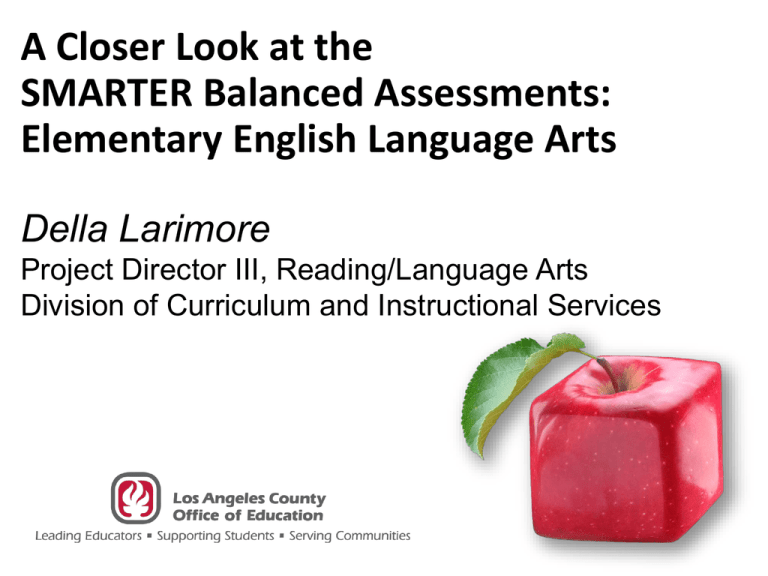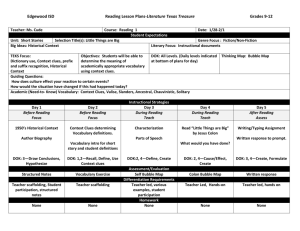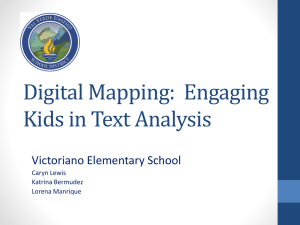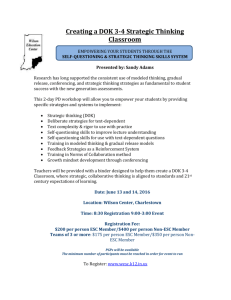Elementary ELA - Della Larimore
advertisement

A Closer Look at the SMARTER Balanced Assessments: Elementary English Language Arts Della Larimore Project Director III, Reading/Language Arts Division of Curriculum and Instructional Services Outcomes By the end of the session, participants will: • Understand the four types of assessment items • Learn about the Depth of Knowledge Levels within assessment items • Identify and discuss instructional supports needed for student success Item Types • Selected response • Constructed-response Technology enhanced • Extended constructed response • Performance Tasks Constructed-response • Students must generate a response Example: Students are provided an information text. Read the text and answer the prompt that follows. Item Prompt: The author uses the pronouns “your” and “you.” Explain how these pronouns develop the idea that laws are important to the reader. Support your answer using details from the text. Technology Enhanced • Constructed Response • Extended Response • Performance Tasks Digital Toolkit Extended Response • Students are often asked to justify their answers • Requires careful scorer and calibration Example: Develop an oral presentation about the comparisons on how information related to theme, topic or events is influenced by different presentations, perspectives or formats. Performance Task • Require more than one class period to complete • Grade 3: 60-90 minutes over two days, one to two tasks • Grades 4-7: 90-120 minutes over two days • Assessing multiple standards • Look at a sample: Investing Sharks Digital Citizenship Item Types • How will you be able to incorporate, or support the use of, different assessment types into your classroom now? Eligible Criteria for a CCSS • Learnable within the school year • Expected content for all students at the grade level/span • Measurable in end-of-year summative assessment • Depth of knowledge ELA Eligibility across grades 3-12 • In grade 3, 35 of 42 standards are eligible • In grade 4 and 5, 35 of 43 standards are eligible • In grades 6-12, 36 of 41 standards are eligible Depth of Knowledge Levels Video available on vimeo.com Depth of Knowledge with Karin Hess http://vimeo.com/20998609 Depth of Knowledge (DOK) • • • • Norman Webb’s research Complexity of cognitive processes Not the verb alone to assign DOK level Ways in which students interact with content Item Design Considerations • Screened standards for on-demand measurability and Depth of Knowledge (DOK) Level 1 (Recall) Level 2 (Basic Skills and concepts) Level 3 (Strategic Thinking and Reasoning) Level 4 (Extended Thinking) DOK Level 1 Recall and Reproduction • Simple procedures and/or formulas • Students either know the information or they don’t • There is a correct answer DOK Level 2 Skills and Concepts • Involves the engagement of some mental processing beyond recall • Requires students to make some decisions about approaches DOK Level 3 Strategic Thinking • Requires deep understanding and the use of higher-order thinking skills • Stating one’s reasoning is a key marker • Requires coordination of knowledge and skill from multiple subject-matter areas • Assessment item with more than one possible answer DOK Level 4 Extended Thinking • High cognitive demand • Students are expected to make connections within the content and solve real-world problems • Employ and sustain strategic thinking processes over a longer period of time What’s the DOK level? Ask yourself: • What level of work are the students most commonly required to perform? • What is the complexity of the task rather than the difficulty? • What are the skills and knowledge the students will need to complete the task? What’s the DOK level? Word Sorts: • Find words in text that illustrate a defined pattern • Create an open sort and define the rule and explain • Sort known words as quickly as possible • How would you take a word sort activity to a level 4? • In what ways will the Depth of Knowledge levels impact your instruction? Draft “Claims” • Board statements of what knowledge and skills that is important to measure • Learning outcomes for the Common Core State Standards • Third feedback period, March 16 • Require evidence Draft “Targets” • Indicates prioritized content for the summative assessment • Shows how one or more of the Common Core State Standards (or parts of standards) address the target Take a Closer Look • Sample item Considerations for Needed Support • Professional development • Teacher support • Instructional Implications











